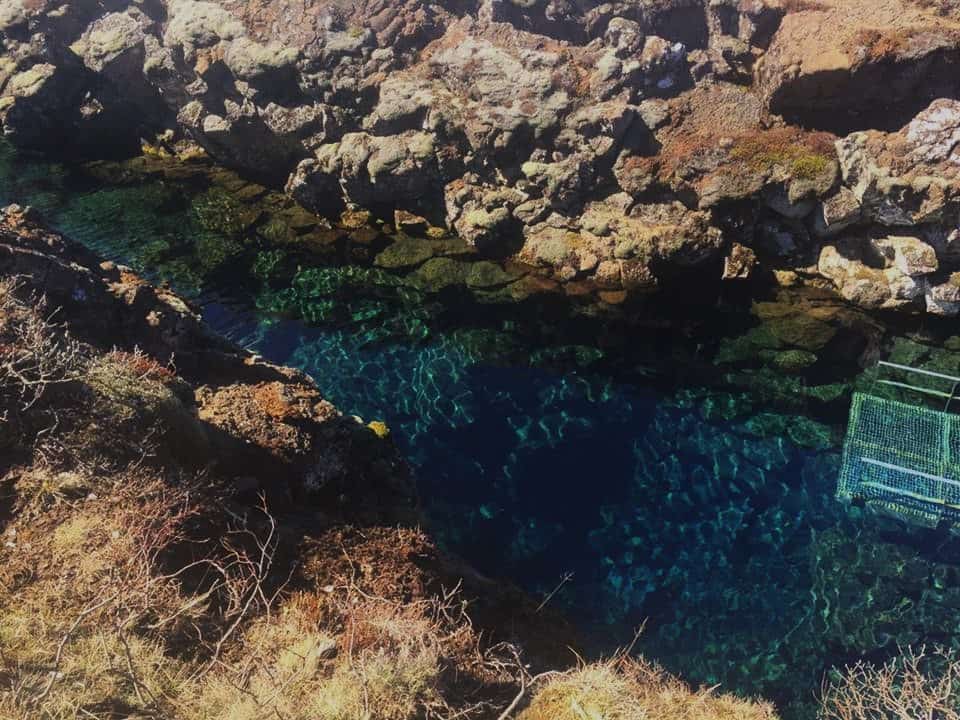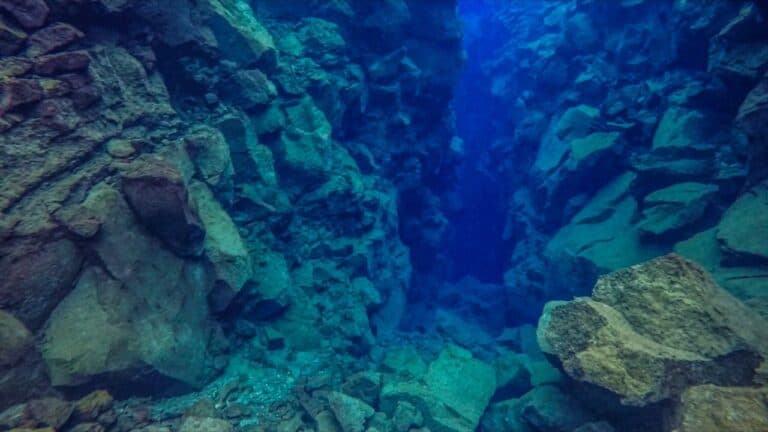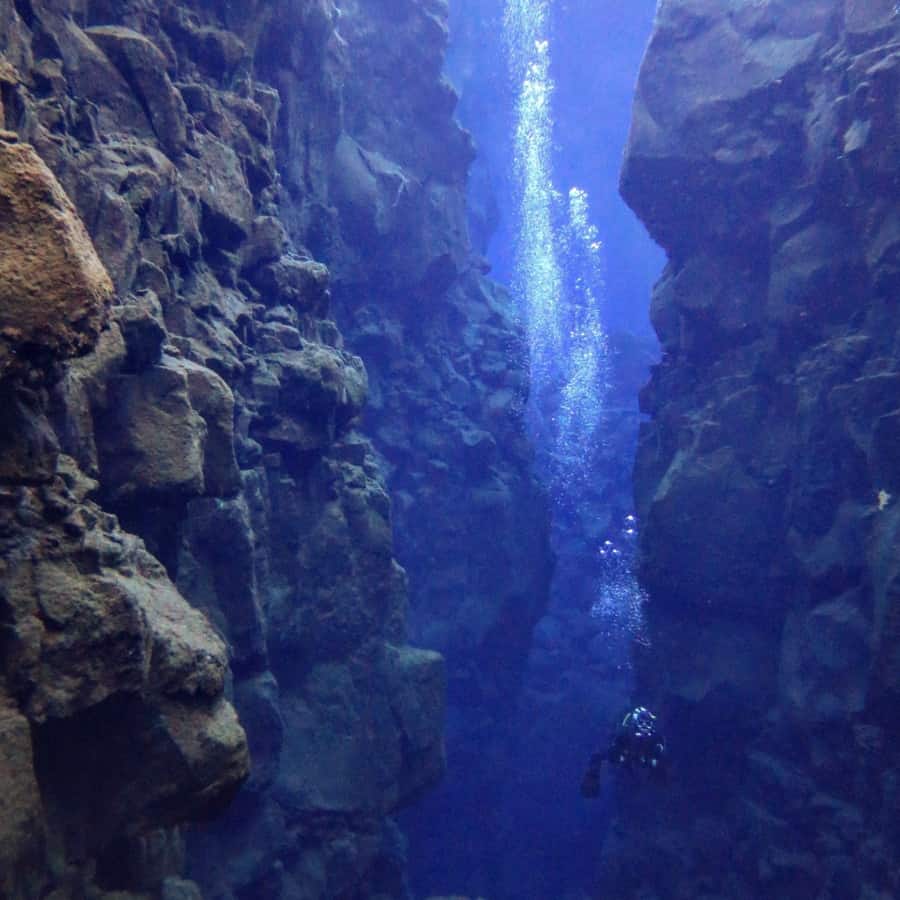Silfra Fissure, Iceland, located in Thingvellir National Park, offers a one-of-a-kind experience between the North American and Eurasian tectonic plates. Formed after a major earthquake in 1789, Silfra was the only fissure filled with pristine glacial meltwater, creating a mesmerizing underwater terrain.
Today, visitors can explore the wonders of this natural phenomenon while diving and snorkeling. immersing themselves in a magical underwater spring found nowhere else on Earth. If you’re looking for an unparalleled adventure, Iceland scuba diving in tectonic plates is a bucket-list experience, allowing you to float effortlessly between continents.
The tectonic plates slowly drift about 2 centimeters every year — constantly reshaping the terrain and creating new caves, tunnels, and fissures. This continuous transformation ensures there’s always something new to discover in this extraordinary geological setting.
What is the Silfra Fissure?
Want to experience the ultimate in Iceland scuba? Tectonic plates make for a pretty cool adventure! Silfra Fissure is the only place on Earth where you can dive directly between two tectonic plates making it a truly a once-in-a-lifetime experience. Formed during the powerful earthquakes of 1789, the Silfra Fissure cracked and connected with an underground spring filled with glacial meltwater that had filtered through the lava for nearly a century.
Despite the icy temperatures, the water never freezes thanks to the constant flow from the spring to the fissure. It offers amazing underwater visibility for advanced divers—often hailed as the clearest water in the world. This unparalleled underwater visibility is why snorkeling and scuba diving in Iceland’s tectonic plates is so incredible, offering a unique chance to immerse yourself in this natural phenomenon. If you want to go diving in Iceland, Silfra is the place to go.
Sections of Silfra
Silfra Fissure is divided into four sections, each offering a distinct diving experience:
- Big Crack: This is the narrowest part of Silfra, where the fissure’s walls come closest together. This section is the highlight for many, as it’s where you can physically see and feel the divide between the North American and Eurasian tectonic plates. The crystal-clear water and the dramatic rock formations make this a breathtaking entry point to Silfra’s underwater world.
- Silfra Hall: Here, the fissure widens into a spacious area with stunning views. The blues and greens of the water stand out, exacerbated by the abundant sunlight. Silfra Hall is a hotspot for taking in the grandeur of the fissure and appreciating the unmatched visibility that stretches for over 100 meters in some spots.
- Silfra Cathedral: This is the most iconic section of the fissure, offering a long, straight passage that feels like an underwater cathedral. This part of the fissure is characterized by its vastness and depth, with the deepest point reaching about 23 meters. The experience of floating through this section is often described as otherworldly, with the sense of being enveloped by endless, clear water.
- Silfra Lagoon: The final section is a shallow area where the fissure widens further. The lagoon provides an excellent opportunity to take in the vibrant colors of the algae-covered rocks and relax after exploring the deeper sections. The visibility here is just as stunning, allowing snorkelers and divers to marvel at the unique underwater landscape one last time before exiting the fissure.
History of Diving in Silfra Fissure
It took hundreds of years for Silfra diving to evolve into the popular activity it is today. Iceland started to gain interest in diving in 1966, when Þröstur Sigtryggson returned to Reykjavik after learning how to dive in the United States. He began offering diving courses to small groups of people who were curious about this new sport. Once people completed his course in Iceland, scuba diving tectonic plates quickly became a sought-after adventure for divers.
One of the early divers described the experience of Iceland tectonic plates diving as unparalleled, thanks to the extraordinary combination of the dramatic terrain and clear water. Silfra’s water, sourced from the nearby Langjökull glacier, is some of the purest and clearest in the world, with an average visibility of 100 meters. When the glacier melts, the water takes between 30 and -100 years to travel through porous underground lava rock (approximately 50 kilometers) and reach the Silfra Fissure. It’s no wonder Silfra is considered one of the best dive sites on the planet!
Where is Silfra?
Silfra Fissure is in Thingvellir National Park, a UNESCO World Heritage Site in southwestern Iceland. This remarkable site lies about 45 kilometers (28 miles) northeast of Reykjavik, making it an accessible and popular destination for locals and visitors. The fissure is nestled within the Mid-Atlantic Ridge, where the North American and Eurasian tectonic plates meet and slowly drift apart.
If you’re traveling by car or camper van, Silfra is a 45-minute drive from Reykjavik. Take Route 1 (the Ring Road) to Mosfellsbær, then follow Route 36 toward Thingvellir National Park. Once in the park, follow the signs to Silfra, where you’ll find designated parking and facilities.
Many companies in Reykjavik offer guided snorkeling and diving tours at Silfra. These tours typically include transportation, equipment for snorkeling and diving activities, and professional dive guides for a safe and immersive experience.
Snorkeling and Diving in Silfra
The Silfra snorkeling experience will stay with you forever!
As the only spot where you can go scuba diving in tectonic plates, Iceland offers unrivaled cold water diving. Before embarking on your journey, it’s essential to know what to expect. Silfra dives require internationally recognized certifications, and all activities within Thingvellir National Park are subject to strict park authority guidelines to ensure safety and environmental protection.
Rules and Regulations
Keep the following in mind while planning your snorkeling adventures:
- You’ll need an Open Water certification from an internationally -recognized diving organization to confirm that you can submerge yourself up to 18 meters without the need for supervision from an instructor.
- Dry suit diving certification is mandatory. Alternatively, you must demonstrate at least 10 logged dives in dry suits within the last two years. Dry suit courses are available if you lack experience, often completed in a single day.
- You’ll need to pay an entrance fee of 1,500 ISK ($11) for each person snorkeling or diving in the park.
- You must be at least 17 years old to participate.
- You can’t dive in caves.
- You can’t dive while wearing a wetsuit
- The maximum depth you can reach is 18 meters.
- Each tour guide can oversee up to three divers or six snorkelers at a time.
- Guides have the authority to assess participants’ medical fitness and may prevent anyone deemed unfit from diving.
- If you’re over the age of 60, you need to provide a health certificate confirming you’re in a position to dive.
- Be prepared to walk 150 meters between the dive center and the dive site, as well as back after the activity.
Health and Safety Guidelines
To ensure safety, certain medical conditions will disqualify you from Silfra tours, including:
- Lung disease
- Obesity
- Inability to carry out moderate exercise (swimming 500 meters and walking 600 meters)
- History of heart attacks, heart surgery, or current heart issues
- Collapsed lungs or chest surgery
- Head injuries or loss of consciousness
- Blood disorders
- Colostomy or ileostomy
- Epilepsy
- Pregnancy
If you have any of the following conditions, you may participate in diving tours only with a doctor’s note certifying your fitness:
- High or low blood pressure
- Type 1 diabetes
- Mild or severe asthma
What You’ll See While Diving
When it comes to Iceland diving, tectonic plates offer more than just more than just breathtaking geological formations—they also introduce you to a diverse underwater ecosystem. While Silfra doesn’t boast abundant marine life due to its low water temperatures, it’s home to fascinating plants and a few hardy creatures that thrive in these extreme conditions.
The plant life in Silfra is dominated by vibrant green algae, which forms soft, moss-like carpets on the rocks and fissures. This greenery creates a beautiful contrast to the clear water, adding to the ethereal beauty of the landscape. You might also notice cyanobacteria, often referred to as blue-green algae, which cling to the fissure walls and contribute subtle hues of green and blue to the underwater landscape.
Silfra has very little life in terms of animals, but it’s home to a few hardy creatures adapted to the cold waters. The Arctic char is the most common fish found in the area. While these fish are more prevalent in Lake Thingvallavatn, some can be spotted swimming through the fissure’s waters as they wander from the lake. Silfra is also rich in microorganisms, including plankton and microbes, which thrive in the nutrient-rich glacial water, although these creatures are too small to be seen by the naked eye.
Unlike other dive sites that are teeming with marine life, Silfra’s charm lies in its surreal visibility and minimalist aquatic environment. Its tranquil beauty, combined with its colorful marine algae and the occasional glimpse of Arctic char, offers a serene diving experience unlike any other.
What to Bring
Heading to Silfra for Iceland scuba diving at its best? To make the most of your experience, it’s important to come prepared with the right gear and documentation. Here’s a checklist to help you get ready:
- Synthetic thermals (avoid cotton)
- Wool or fleece socks
- Spare outfit to change into, in case you get wet
- Towel
- A letter from your doctor confirming that you can perform the dive (if you have asthma, type 1 diabetes, high or low blood pressure)
- Open Water and Dry Suit Certifications
Note that any letters and certifications need to be in English; so the guide can easily read and confirm compliance with the rules and regulations. Since there are no lockers available at Silfra, avoid bringing items that require storage. It’s best to consult with your guide on the equipment you’ll need for snorkeling and diving tours. You might be allowed to bring your own if it meets the rules and regulations.
Where to Stay
After your diving adventure at Silfra, finding a comfortable and convenient place to stay is essential. Iceland offers wide-ranging accommodations, but if you’re looking for flexibility and a closer connection to nature, consider staying at a campsite. Campsites are perfect for those traveling in campervans, allowing you to park and rest near some of Iceland’s most breathtaking landscapes.
- Thingvellir National Park Campsite: Just minutes away from Silfra, this campsite is a go-to base for divers. Facilities include restrooms, showers, and access to hiking trails, making it a convenient and scenic option.
- Laugarvatn Campsite: Approximately 30 minutes from Silfra, this campsite offers beautiful lake views and amenities like electricity, restrooms, and cooking facilities. It’s a peaceful spot for relaxing after a day of diving.
- Selfoss Campsite: Situated about an hour away, this larger campsite provides excellent facilities, including laundry services and Wi-Fi, ideal for those seeking additional comforts.
Let Rent.is Get You Between Two Continents
Diving in Iceland’s Silfra Fissure is a once-in-a-lifetime experience. Rent.is can provide a top-of-the-line camper rental in Iceland to help you explore the country’s landscapes as you make your way to this extraordinary site. Iceland tectonic plates diving has never been more accessible—start your adventure with Rent.is today!

FAQs
How deep is the Silfra fissure?
The maximum depth of Silfra is approximately 63 meters (207 feet), but most dives are limited to 18 meters (59 feet).
How cold is the water?
The water temperature stays between 2–4°C (36–39°F) year-round.
How do I get to Silfra?
Silfra is located in Thingvellir National Park, about a 50-minute drive from Reykjavik. Follow Route 36 east to reach the park.
Can I buy food at Silfra?
No, there are no food facilities at Silfra. It’s best to bring your own snacks or eat at nearby towns.
What facilities are available at Silfra?
Facilities include restrooms and parking. There are no lockers or changing rooms, but tour operators often provide changing tents.
How long are the diving trips?
Diving trips typically last 2–4 hours, including preparation and underwater time.
When is the best time to dive the tectonic plates in Iceland?
If you want to scuba dive Iceland’s tectonic plates, the best time is during summer (June–August) for optimal weather, but diving is available throughout the year.
How far is the drive from Reykjavik?
The drive from Reykjavik to Silfra is about 50 kilometers (31 miles), or approximately 50 minutes.


